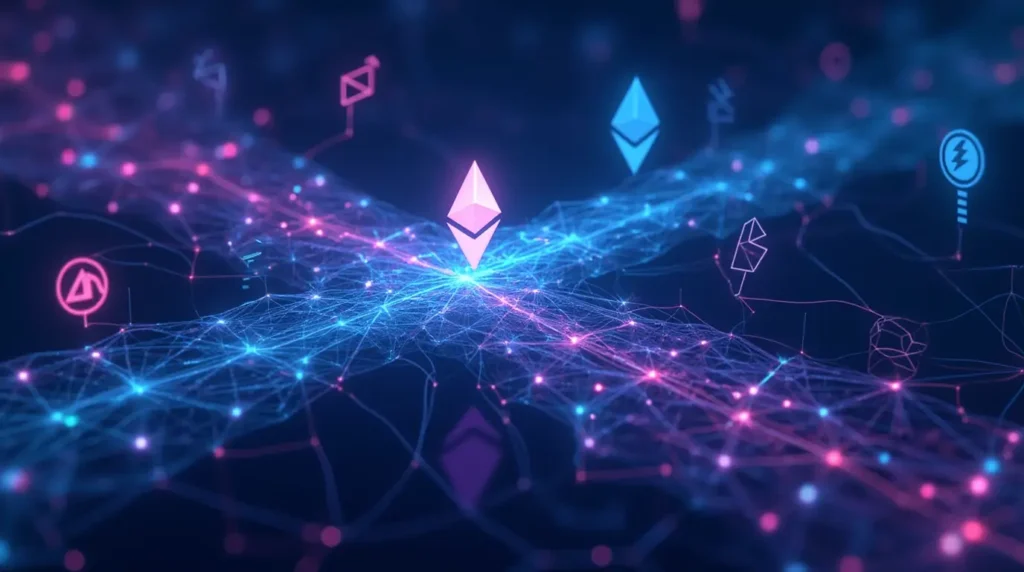Table of Contents
The blockchain ecosystem is evolving rapidly, and with it, the need for best cross chain swaps has become more critical than ever. As Layer 2 (L2) rollups and new chains like Arbitrum, Optimism, and Base gain traction, liquidity is becoming increasingly fragmented. This fragmentation makes it harder for traders to access the best prices and liquidity pools across different chains.
Enter Uniswap and Across Protocol, two giants in the decentralized finance (DeFi) space, who have joined forces to simplify cross-chain trading. This partnership introduces a groundbreaking solution that eliminates the complexities of manual bridging, making cross-chain swaps faster, cheaper, and more accessible.
In this article, we’ll explore:
- What cross-chain swaps are and why they matter.
- How Uniswap and Across are revolutionizing decentralized trading.
- The benefits of this integration for traders like you.
- A step-by-step guide to performing cross-chain swaps on Uniswap.
Ready to dive in? Let’s get started!
Understanding the Cross-Chain Problem
What Are Cross Chain Swaps?
Cross-chain swaps allow users to trade assets across different blockchain networks. For example, you might want to swap Ethereum (ETH) on the Ethereum mainnet for Arbitrum’s native token (ARB) on the Arbitrum chain.
Why Is This Important?
The crypto space is no longer dominated by just Ethereum and Bitcoin. Chains like Arbitrum, Optimism, Base, and Polygon are rising in popularity, each offering unique features and deeper liquidity pools for specific assets. However, this variety also creates challenges:
- Fragmented Liquidity: Liquidity is spread across multiple chains, making it harder to find the best prices.
- Manual Bridging: Traders often have to manually bridge assets between chains, which is time-consuming and expensive.

The Challenges of Cross-Chain Transactions
Cross-chain trading isn’t as simple as it sounds. Here’s why:
- Multiple Steps: Bridging assets and swapping tokens often require separate transactions.
- High Fees: Gas fees and bridge fees can add up quickly.
- Slow Transactions: Traditional bridges can take minutes or even hours to process transfers.
- Security Risks: Manual bridging increases the risk of errors and vulnerabilities.
This is where the Uniswap and Across partnership comes in, offering a streamlined solution to these challenges.
Why Cross-Chain Trading is So Important
Cross-chain trading isn’t just a buzzword—it’s a game-changer for DeFi users. Here’s why:
- Access to Deeper Liquidity: Find better prices and larger liquidity pools across multiple chains.
- Arbitrage Opportunities: Capitalize on price differences between chains.
- Portfolio Diversification: Easily move assets between chains to explore new opportunities.
For example, if you find better liquidity for a token on Arbitrum but your funds are on Ethereum, cross-chain swaps make it easy to access that liquidity without manual bridging.
What Makes Cross-Chain Transactions Challenging?
Cross-chain trading involves several steps, each adding complexity and cost:
- Bridging Assets: Transfer tokens from one chain to another using a bridge.
- Paying Fees: Gas fees, bridge fees, and transaction fees can stack up.
- Waiting for Confirmation: Traditional bridges can take time to process transactions.
- Swapping Tokens: Once bridged, you may need to swap tokens on the destination chain.
This process is not only cumbersome but also expensive and time-consuming.
Uniswap and Across: A Groundbreaking Collaboration
Uniswap, the leading decentralized exchange (DEX), has teamed up with Across Protocol, a fast and secure bridging solution, to simplify cross-chain swaps. This partnership allows users to bridge and swap tokens in a single step, eliminating the need for manual bridging.
Across’s Intent-Based Bridging: What’s the Big Deal?
Across Protocol uses intent-based bridging, a revolutionary approach that simplifies cross-chain transactions. Here’s how it works:
- User Specifies Intent: You define what you want to do (e.g., swap ETH for ARB).
- Across Handles the Rest: The protocol automatically bridges and swaps your tokens.
This method is:
- Fast: Transactions under $10,000 are completed in just 3 seconds.
- Cost-Effective: Lower fees compared to traditional bridges.
- Secure: Built by Risk Labs, the team behind Universal Market Access (UMA).
Across has already bridged over 12.7 billion in lifetime volume, with daily volumes ranging between 20-40 million.

Across Protocol and Its Impact
Its bridging solution is designed for speed and efficiency, ensuring that 99% of all L2 transactions (which are typically under $10,000) are processed in mere seconds.
Supported Chains and Tokens
The Uniswap and Across integration supports the following EVM-compatible chains and tokens:
Supported Chains:
- Ethereum
- Base
- Arbitrum
- Polygon
- Optimism (OP Mainnet)
- Blast
- ZKsync
- Zora
- World Chain (announced)
Supported Tokens:
- Stablecoins (USDC, DAI, etc.)
- Wrapped Bitcoin (WBTC)
- Native Chain Assets (ETH, OP, ARB)
The tokens eligible for this integration encompass stablecoins, WBTC (Wrapped Bitcoin), and native chain assets such as ETH, OP, and ARB. Whether swapping ETH for ARB or transferring stablecoins across L2 chains, this integration simplifies things considerably.
check this article about How to Swap Cross-Chain Stablecoins Quickly.
The ERC-7683 Token Standard: Simplifying Cross Chain Transactions
Uniswap and Across have co-developed ERC-7683, a new token standard designed to streamline cross-chain swaps. Here’s what it does:
- Standardizes Cross-Chain Swaps: Provides a framework for DEXs and bridges to execute transactions across chains.
- Enables Solvers/Relayers: Allows intermediaries to facilitate swaps on behalf of users.
- Enhances Security: Maintains compatibility with existing messaging networks.
This means faster, more efficient cross-chain swaps without compromising on security.


This means that, as a user, you’ll benefit from faster, more efficient cross-chain trades without sacrificing the security or decentralization that DeFi is known for.
How Does This Benefit You as a Trader?
Here’s how the Uniswap and Across integration benefits you:
1. Faster Transactions
- Cross-chain swaps are completed in seconds, not minutes or hours.
- Ideal for taking advantage of arbitrage opportunities or moving funds quickly.
2. Lower Fees
- Fewer steps mean lower gas and transaction fees.
- Save money when trading across Layer 2 chains.
3. Greater Access to Liquidity
- Access liquidity pools across multiple chains without manual bridging.
- Always get the best prices for your trades.

How to Perform Cross-Chain Swaps on Uniswap
Here’s a step-by-step guide to performing cross-chain swaps on Uniswap:
- Connect Your Wallet: Use MetaMask, WalletConnect, or another compatible wallet.
- Select Tokens and Chains: Choose the tokens you want to swap and specify the source and destination chains.
- Bridge and Swap: Uniswap will use Across’s bridging infrastructure to handle the swap in one step.
- Confirm and Pay Fees: Review the transaction details and confirm.
That’s it! You’ve successfully performed a cross-chain swap without leaving Uniswap.
FAQs
1. What is intent-based bridging?
Intent-based bridging lets you define your transaction’s goal—like swapping tokens—and Across takes care of the process. This removes the need to manually bridge tokens between different blockchains.
2. What is ERC-7683?
ERC-7683 is a new token standard created by Uniswap and Across that streamlines cross-chain swaps. It allows relayers or solvers to manage transactions across various blockchains seamlessly.
3. Which chains are supported in this integration?
This integration supports nine EVM-compatible chains, including Ethereum, Base, Arbitrum, and others.
4. What tokens can be used for cross-chain swaps?
Currently, supported tokens include stablecoins (like USDC and DAI), Wrapped Bitcoin (WBTC), and native assets such as ETH, OP, and ARB.
5. How fast are cross-chain swaps with Across?
Across targets a transfer time of just 3 seconds for transactions under $10,000.
6. How can I use this feature on Uniswap?
Connect your wallet to Uniswap, select the tokens and chains for your trade, and Uniswap will use Across’s bridging system to complete the swap.
Conclusion
The Uniswap and Across partnership is a game-changer for decentralized trading. By simplifying cross-chain swaps, this integration makes it easier than ever to access liquidity, save on fees, and trade across multiple chains.
Whether you’re a seasoned trader or new to DeFi, now is the perfect time to explore cross-chain swaps on Uniswap. Ready to get started? Try it out today and experience the future of decentralized trading!
Related Articles for More Details
If you found this article helpful, check out these related guides to deepen your understanding of DeFi and cross-chain trading:
- How Decentralized Finance is Transforming Banking
Discover how DeFi is reshaping traditional banking and financial systems. - Top Decentralized Finance Companies to Watch
Learn about the leading companies driving innovation in the DeFi space. - Blockchain Use Cases in Finance
Explore how blockchain technology is being applied to solve real-world financial challenges. - Solana Swap: A Beginner’s Guide
Understand how swapping works on Solana and how it compares to Ethereum-based swaps. - Jupiter Bridge on Solana: Simplifying Cross-Chain Transactions
Learn about Jupiter Bridge, a cross-chain solution for the Solana ecosystem.





